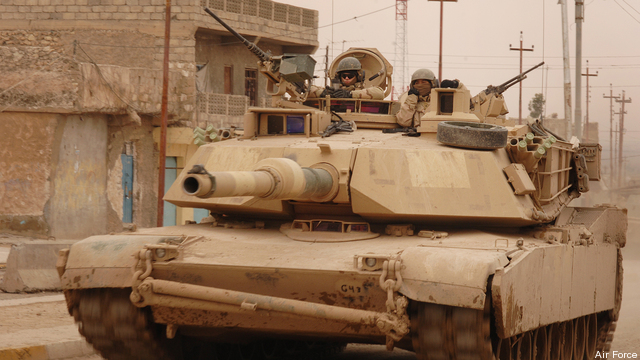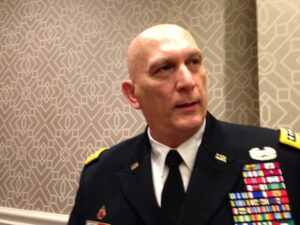Full Speed Ahead On Wargames: Gen. Odierno
Posted on

ARLINGTON: The US Army is trying to reinvent itself, much as it did during the Great Depression. Even if the steep cuts called sequestration return in 2016 — as is current law — the Army would rather get smaller than shortchange innovation, Chief of Staff Ray Odierno said today. The service will hold annual wargames on new ways of fighting, Gen. Odierno said, the first of them this August on the concept formerly known as Air-Sea Battle.
“To me, it’s an exciting time in the Army because it’s a time of great change,” Odierno told an Association of the US Army breakfast this morning. “I can sit up here and talk about ‘oh, woe is us, I’m worried about sequestration’ — [and] I am worried about it…but we cannot stop innovating. In fact, a time of decreased resources requires us to do the innovation.”

Gen. Ray Odierno
The first exercise will look at how the Army fits into the concept originally called “Air-Sea Battle,” now formalized in joint doctrine as the much clunkier “Joint Concept for Access and Maneuver in the Global Commons.” The original Air-Sea Battle concept focused on how the Air Force and Navy would break open layered defenses like those of China or Iran — known as “anti-access/area denial” (A2/AD) systems. The new, broader concept also explores what you do once you get access, such as deploying ground forces.
So, said Odierno, “in the first week of August, out at the National Training Center [Fort Irwin, California], we are going to do a ‘joint early entry operation’ which includes special operations forces, conventional [land] forces, air forces, naval forces, in order to develop the concept that is necessary to ensure we can get our ground forces on the ground anywhere in the world.”
What he didn’t say was that such rapid deployments have been a chronic headache for the heavily equipped Army (and a core strength of the less well-armed Marine Corps) at least since the 82nd Airborne deployed to Saudi Arabia in 1990 as a “speed bump” against Saddam Hussein. After a decade of uparmoring everything to survive roadside bombs in Afghanistan and Iraq, the Army is looking to get lighter and faster again.
All that’s just wargame No. 1. Next year, the Army will launch a series of annual exercises specifically designed to explore the 20 “warfighting challenges” — from cyber tactics to influencing local leaders — identified in the recent Army Operating Concept. (The working title for these wargames is “Army Warfighting Assessments,” but Odierno told reporters that name will change). The first wargame will be at Fort Bliss, Texas, with “about 15” foreign militaries participating, he said.
Starting with that 2016 wargame, Odierno explained to the press, “we’re going to do annual exercises that enable us to look at new concepts — joint concepts and ground concepts — that enable us to respond across the spectrum of conflict” from training and advising missions (as in Iraq and now, Ukraine) to high-end combined-arms warfare.
“It’ll help us develop a variety of options that we give our national security leaders,” Odierno said.
The Army’s pulled this off before. In the 1920s and ’30s, junior officers like George Patton, Dwight Eisenhower, and Hap Arnold laid the intellectual and technological foundation for the force of tanks and aircraft that won World War II. In the “hollow force” era after Vietnam — to which Odierno said sequester would return us — the Army developed the “AirLand Battle” tactics that won the first Gulf War. During the post-Cold War downsizing of the 1990s, Chief of Staff Gordon Sullivan’s “digitization” programs and wargames developed the wireless command-and-control networks that enabled the blitzkrieg on Baghdad in 2003.
But this time may be different, said Gen. Sullivan, who’s now president of AUSA. Compared to his own experience in the 1990s, he told me after Odierno’s remarks, “This is much more challenging [because the Army has] many more commitments.”
“Today we have about 45,000 soldiers deployed, most people don’t understand that,” Odierno told AUSA. “So we’re busy.”
Odierno gave few details on the newest of those missions, an effort announced yesterday to train Ukrainian troops in small-unit tactics and leadership. He also declined to speculate whether the US advisor mission in Iraq would grow beyond the 3,100 currently authorized. But when pressed by the press after his public talk, Odierno said his list of worries was “pretty close” to the one outlined by Pentagon intelligence chief Mike Vickers yesterday.
“What is the existential threat to the United States? No. 1 is terrorism,” Odierno told reporters. “But I also believe Russia, China, nuclear proliferation, Iranian aggression in the Middle East, the underlying conflicts in the Middle East, all could create incredible economic instability, which affects security… and we don’t know which one is going to pop up and which one becomes most important.”
“That’s the challenge,” he said. “We have to be prepared to respond” — but we don’t know where, when, or how.
Does Congress understand the stakes?
“Last night we did a meeting over at the Pentagon with all the new senators,” Odierno told reporters. “I met with every single one of them, and every single one of them said they believe we need to end sequestration on the military. The issue is how you get there, and that’s what they have to work through.”
“We’ll see,” he said. “I have learned not to predict things in Washington.”
Subscribe to our newsletter
Promotions, new products and sales. Directly to your inbox.
